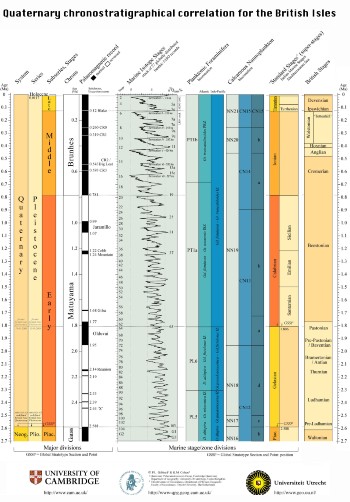 The Quaternary of the British Isles contains a diverse variety of glaciogenic sediments, non-glaciogenic terrestrial and marine deposits scattered across large parts of the British Isles. These can be broadly grouped into major units, and can be divided at a much finer scale into chronostratigraphic and lithostratigraphic units.
The Quaternary of the British Isles contains a diverse variety of glaciogenic sediments, non-glaciogenic terrestrial and marine deposits scattered across large parts of the British Isles. These can be broadly grouped into major units, and can be divided at a much finer scale into chronostratigraphic and lithostratigraphic units.
In the introduction of the Geological Society volume A correlation of Quaternary deposits in the British Isles (Mitchell et al. 1973), Fred Shotton notes that "although the Quaternary covers a much shorter period of time than any other system, its deposits…embody a record of great climatic fluctuations which are the outstanding feature of the era and it has long been accepted in most parts of the world that these climatic cycles are the natural basis for time sub-divisions". This concept provided the basis for the subdivision proposed in the Mitchell et al. (1973) volume. The table of stages they proposed, modified by the addition of stages defined subsequently until 1980, has not been updated although additional events have been recognised during various parts of the sequence. For example, in the Middle Pleistocene, the Cromerian is known to represent a long period during which several (possible five) interglacial events occurred, of which that at West Runton is potentially the second (cf. the ‘Cromerian Complex’ stage of the Netherlands). Additional interglacial-scale climatic events are also known to have occurred during the Wolstonian Stage (cf. the Saalian Stage complex of the western European mainland).
The development of the oxygen isotope record derived from foraminiferal tests in ocean-floor sediments, a Marine Isotope Stage (MIS) system became established. The isotope stages recognised the eastern Pacific (core V28-238; Shackleton & Opdyke, 1976), are generally regarded as the ‘type’ for the later Quaternary, whilst those defined in core ODP 677 and 846 are those for the Pliocene to Middle Pleistocene. However, the correlations presented in the chart (Cohen & Gibbard 2010), still include uncertainties, particularly beyond the last interglacial, the Ipswichian Stage. Full discussion of these points, is presented by Gibbard & van Kolfschoten (2005) and Gibbard et al. (2008). The chronostratigraphy of the Quaternary is the responsibility of the International Subcommission on Quaternary Stratigraphy.
Back to Summary
Further Information
Cohen K.M. & Gibbard, P. (2010). Global chronostratigraphical correlation table for the last 2.7 million years. Subcommission on Quaternary Stratigraphy (International Commission on Stratigraphy), Cambridge, England.
Gibbard, P.L. & Kolfschoten, van Th. (2005). Pleistocene and Holocene Series. In: Gradstein, F. Ogg, J. & Smith A.G. (editors) Geological Time Scale 2004. University Press: Cambridge.
Gibbard, P.L. & West, R.G. (2000). Quaternary chronostratigraphy: the terminology of terrestrial sequences. Boreas 29, 329-336.
Gibbard, P, Cohen, K. & Ogg, J. The Quaternary Period. Ch. 15. In: Ogg, J., Ogg, G. & Gradstein, F. (eds) (2008). A concise Geologic Timescale. 149-158. Cambridge University Press.
McMillan, A., Hamblin, R. J O; Merritt, J. (2005). An overview of the lithostratigraphic framework for the Quaternary and Neogene Deposits of Britian (onshore). British Geological Survey, research report RR/04/04.
Mitchell, G.F., Penny, L.F., Shotton, F.W. and West. R.G. (1973). A correlation of the Quaternary deposits of the British Isles. Geological Society of London, Special Report 4, 99pp.
Shackleton,.N.J. & Opdyke, N. (1976). Oxygen isotope and palaeomagnetic stratigraphy of equatorial Pacific core V28-238: oxygen isotope temperatures and ice volume on a 105 and 106 year scale. Quaternary Research 3, 39-55.
Shotton, F.W. (1973). General principles governing the subdivision of the Quaternary System. 1-7 In: Mitchell, G.F., Penny, L.F., Shotton, F.W. and West. R.G. A correlation of the Quaternary deposits of the British Isles. Geological Society of London, Special Report 4, 99pp.
(PG, MWH)